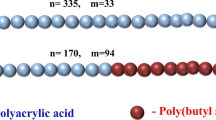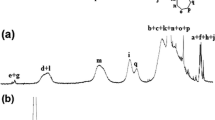Abstract
Lysozyme is an enzyme responsible for the damage of bacterial cell walls and is abundant in a number of secretions such as tears and human milk. In the present study, we investigated the structure, the physicochemical characteristics, and the temperature-responsiveness of lysozyme complexes with poly(N-isopropylacrylamide)-b-poly(acrylic acid) block polyelectrolyte in aqueous media. A gamut of light-scattering techniques and fluorescence spectroscopy were used in order to examine the complexation process, as well as the structure, solution behavior, and temperature response of the nanosized complexes. The concentration of copolymer polyelectrolyte was kept constant. The values of the scattering intensity, I 90, which is proportional to the mass of the species in solution, increased gradually as a function of C LYS, providing proof of the occurring complexation, while the size of the nanostructures decreased. The structure of the complexes became more open as the C LYS increased. The increase of the salinity did not affect the structural characteristics of the supramolecular nanoparticulate aggregates. On the other hand, the physicochemical and structural characteristics of the complexes changed upon increasing temperature, and the changes depended on the initial ratio block polyelectrolyte/lysozyme. The knowledge on developing block polyelectrolyte/protein complexes through electrostatic interactions, obtained from this investigation, may be applied to the design of nutraceuticals.









Similar content being viewed by others
References
Abeyrathne EDNS, Lee HY, Ahn DU (2013) Egg white proteins and their potential use in food processing or as nutraceutical and pharmaceutical agents—a review. PoultSci 92:3292–3299
Al-Tahami K, Singh J (2007) Smart polymer based delivery systems for peptides and proteins. Recent Pat Drug Deliv Formul 1:65–71
AnnakaM MK, Okabe S (2007) Electrostatic self-assembly of neutral and polyelectrolyte block copolymers and oppositely charges surfactant. J Phys Chem B 111:11700–11707
Artym J, Zimecki M (2013) Milk-derived proteins and peptides in clinical trials. PostpyHig Med Dosw 67:800–816
Becker AL, Henzler K, Welsch N, Ballauff M, Borisov O (2013) Proteins and polyelectrolytes: a charged relationship. CurrOpin Colloid Interface Sci 17:90–96
Borchert U, Lipprandt U, Bilang M, Kimpfler A, Rank A, Peschka-Süss R, Scubert R, Lindner P, Förster S (2006) pH-induced release from P2VP-PEO block copolymer. vesicles 22:5843–5847
Burchard W (1983) Static and dynamic light scattering from branched polymers and biopolymers. Adv Polym Sci 48:1–124
Cerritelli S, Velluto D, Hubbell JA (2007) PEG-SS-PPS: reduction-sensitive disulfide block copolymer vesicles for intracellular drug delivery. Biomacromolecules 8:1966–1972
Cooper CL, Dubin PL, Kayitmazer AB, Turksen S (2005) Polelectrolyte-protein complexes. Curr Opin Colloid Interface Sci 10:52–78
Du J, Armes SP (2005) pH-responsive vesicles based on hydrilytically self-cross-linkable copolymer. J Am Chem Soc 127:12800–12801
Du J, Tang Y, Lewis AL, Armes SP (2005) pH-sensitive vesicles based on a biocompatible zwitterionic diblock copolymer. J Am Chem Soc 127:17982–17983
Fundueanu G, Constantin M, StanciuC TG, Ascenzi P (2009) pH- and temperature-sensitive polymeric microspheres for drug delivery: the dissolution of copolymers modulates drug release. J Mater Sci Mater Med 20:2465–2475
Gaucher G, Dufresne MH, Sant VP, Kang N, Maysinger D, Leroux JC (2005) Block copolymer micelles: preparation, characterization and application in drug delivery. J Control Release 109:169–188
Gong C, Qi T, Wei X, Qu Y, Wu Q, Luo F, Qian Z (2013) Thermosensitive polymeric hydrogels as drug delivery systems. Curr Med Chem 20:79–94
Hardy G (2000) Nutraceuticals and functional foods: introduction and meaning. Nutrition 16:688–689
Karayianni M, Pispas S, Chryssikos GD, Gionis V, Giatrellis S, Nounesis G (2011) Complexation of lysozyme with poly (sodium (sulfamate-carboxylate) isoprene). Biomacromolecules 12:1697–1706
Karayianni M, Pispas S (2012) Complexation of stimuli-responsive star-like amphiphilic block polyelectrolyte micelles with lysozyme. Soft Matter 8:8758–8769
Kalra EK (2003) Neutraceutical—definition and introduction. AAPS Pharm Sci 5:E25
Kanwar JR, Kanwar RK, Sun X, Punj V, Matta H, Morley SM, Parratt A, Puri M, Sehgal R (2009) Molecular and biotechnological advances in milk proteins in relation to human health. Curr Protein Pept Sci 10:308–338
Kiese S, Papppenberger A, Friess W, Mahler HC (2008) Shaken, not stirred: mechanical stress testing of an IgG1 antibody. J Pharm Sci 97:4347–4366
Kovacs-Nolan JKN, Phillips M, Mine Y (2005) Advances in the values of eggs and egg components for human health. J Agric Food Chem 53:8421–8431
Lakowicz JR (1980) Fluorescence spectroscopic investigations of the dynamic properties of proteins, membranes and nucleic acids. J Biochem Biophys Methods 2:91–119
Li G, Song S, GuoL MSJ (2008) Self-assembly of thermo- and pH-responsive poly(acrylic acid)-b-poly (N-isopropylacrylamide) micelles for drug delivery. PolymSci Part A: PolymChem 46:5028–5035
Lin JL, Ruaan RC, Hsieh HJ (2007) Refolding of partially and fully denaturated lysozymes. Biotechnol Lett 29:723–729
Liu X, Luo S, Ye J, Wu C (2012) Effect of Ca2+ ion and temperature on association of thermally sensitive PAA-b-PNIPAM diblock chains in aqueous solutions. Macromolecules 45:4830–4838
Mahler HC, Friess W, Grauschopf U, Kiese S (2009) Protein aggregation: pathways, induction factors and analysis. J Pharm Sci 98:2909–2934
McDonald P, Victa C, Carter-Franklin JN, Fahrner R (2009) Selective antibody precipitation using polyelectrolytes: a novel approach to the purification of monoclonal antibodies. Biotechnol Bioeng 102:1141–1151
McGuire R, Feldman I (1975) Static and dynamic quenching of protein fluorescence II lysozyme. Biopolymers 14:1095–1102
Mine Y, Ma F, Lauriau S (2004) Antimicrobial peptides released by enzymatic hydrolysis of hen egg white lysozyme. J Agric Food Chem 52:1088–1094
Morozova-Poche LA (2007) Equine lysozyme: the molecular basis of folding, self-assembly and innate amyloid toxicity. FEBS Lett 581:2587–2592
Pelton R (2010) Poly(N-isopropylacrylamide) (PNIPAM) is never hydrophobic. J Colloid Interface Sci 348:673–674
Pergushov DV, Remizova EV, Feldthusen J, Zezin AB, Müller AHE, Kabanov VA (2003) Novel water-soluble micellar interpolyelectrolyte complexes. J Phys Chem B 107:8093–8096
Pergushov DV, Müller AH, Schacher FH (2012) Micellar interpolyelectrolyte complexes. Chem Soc Rev 41:6888–6901
Pippa N, Karayianni M, Pispas S, Demetzos C (2015a) Complexation of cationic-neutral block polyelectrolyte with insulin and in vitro release studies. Int J Pharm 491:136–143
Pippa N, Kalinova R, Dimitrov I, Pispas S, Demetzos C (2015b) Insulin/poly(ethylene glycol)-block-poly(L-lysine) complexes: physicochemical properties and protein encapsulation. J Phys Chem B 119:6813–6819
Pişkin E (2004) Molecularly designed water soluble, intelligent, nanosized, polymeric carriers. Int J Pharm 277:105–118
Pispas S (2007) Complexes of lysozyme with sodium (sulfamate-carboxylate) isoprene/ethylene oxide double hydrophilic block copolymers. J Polym Sci Part A: Polym Chem 45:509–520
Schilli CM, Zhang M, Rizzardo E, Thang SH, Chong YK, Edwards K, Karlsson G, Müller AHE (2004) A new double-responsive block copolymer synthesized via RAFT polymerization: poly(N-isopropylacrylamide)-block-poly (acrylic acid). Macromolecules 37:7861–7866
Sediq AS, Nejadnik MR, El Bialy I, Witkamp GJ, Jiskoot W (2015) Protein-polyelectrolyte interactions monitoring particle formation and growth by nanoparticle tracking analysis and flow imaging microscopy. Eur J Pharm Biopharm 93:339–345
Sigolaeva LV, Pergushov DV, Synatschke CV, Wolf A, Dewald I, Kurochkin IN, Fery A, Müller AHE (2013) Co-assemblies of micelle-forming diblock copolymers and enzymes on graphite substrate for and improved design of biosensor systems. Soft Matter 9:2858–2868
Talelli M, Hennink WE (2011) Thermosensitive polymeric micelles for targeted drug delivery. Nanomedicine (Lond) 6:1245–1255
Wan Y, Lu J, Cui Z (2006) Separation of lysozyme from chicken egg white using ultrafiltration. SeparPurif Tech 48:133–142
Zhang Y, Han K, Lu D, Liu Z (2013) Reversible encapsulation of lysozyme within mPEG-b-PMAA: experimental observation and molecular dynamics simulation. Soft Matter 9:8723–8729
Zhao J, Zhang G, Pispas S (2009) Thermo-induced aggregation behavior of poly(ethylene oxide)-b-poly (N-isopropylacrylamide) block copolymers in the presence of cationic surfactants. J Phys Chem B 113:10600–10606
Acknowledgements
Authors acknowledge financial support of the work by the NANOMACRO 1129 project which is implemented in the framework of the Operational Program “Education and Life-long Learning” (Action “ARISTEIA I”) and it is co-funded by the European Union (European Social Fund) and by national funds. The authors would like to thank Dr. Aggeliki Siamidi for her help in editing this manuscript.
Author information
Authors and Affiliations
Corresponding author
Ethics declarations
Conflict of interest
The authors declare that they have no conflict of interest.
Rights and permissions
About this article
Cite this article
Pippa, N., Meristoudi, A., Pispas, S. et al. Lysozyme complexes with thermo- and pH-responsive PNIPAM-b-PAA block copolymer. J Nanopart Res 19, 76 (2017). https://doi.org/10.1007/s11051-017-3782-1
Received:
Accepted:
Published:
DOI: https://doi.org/10.1007/s11051-017-3782-1




